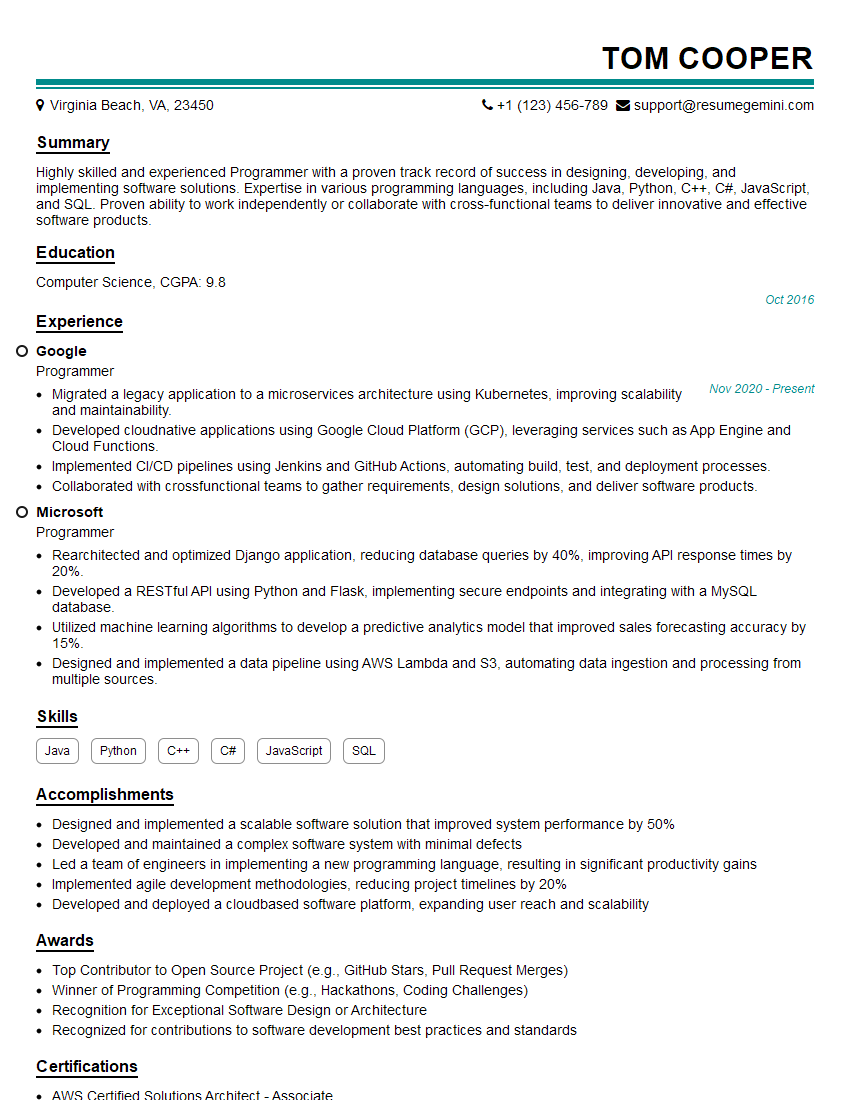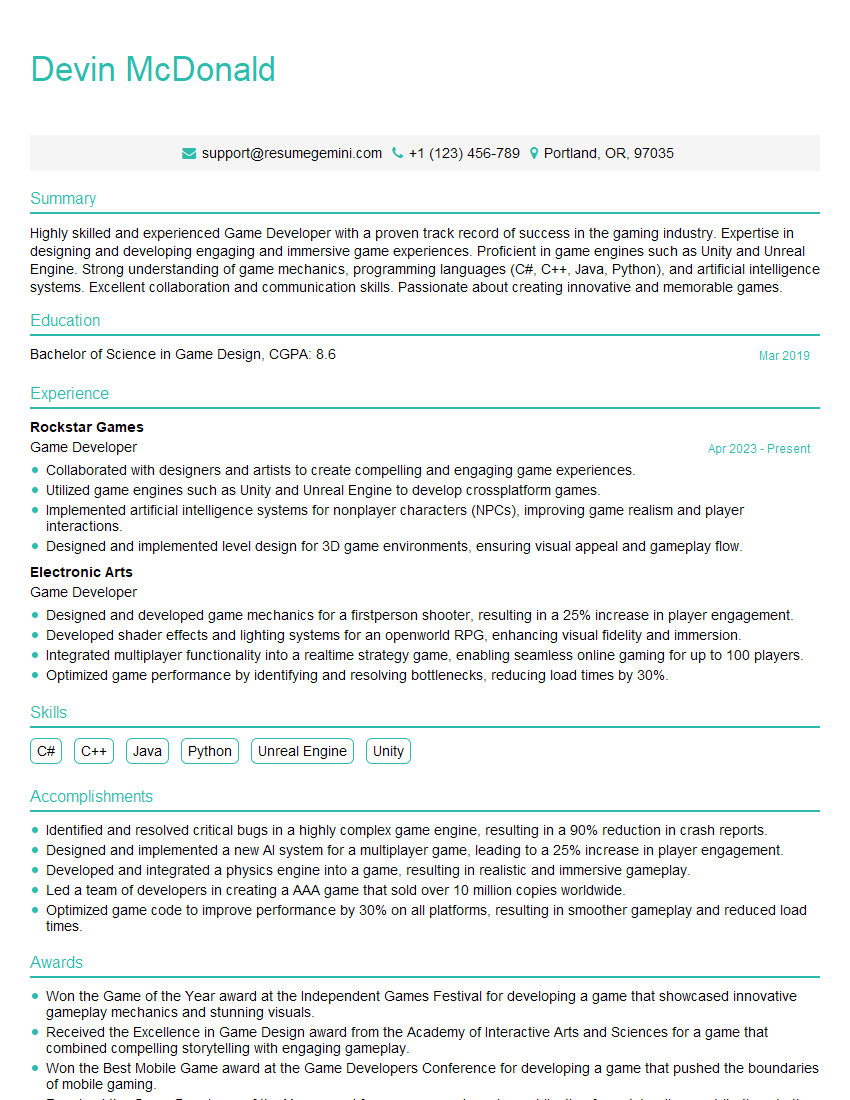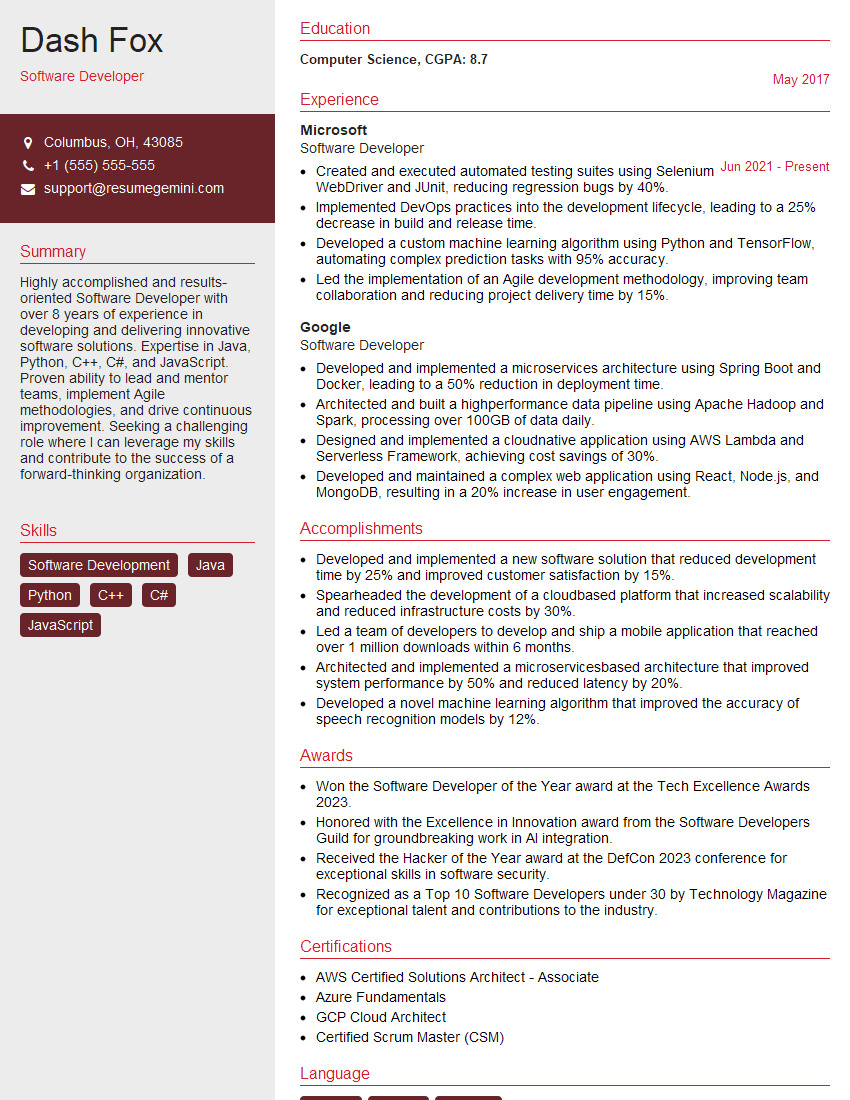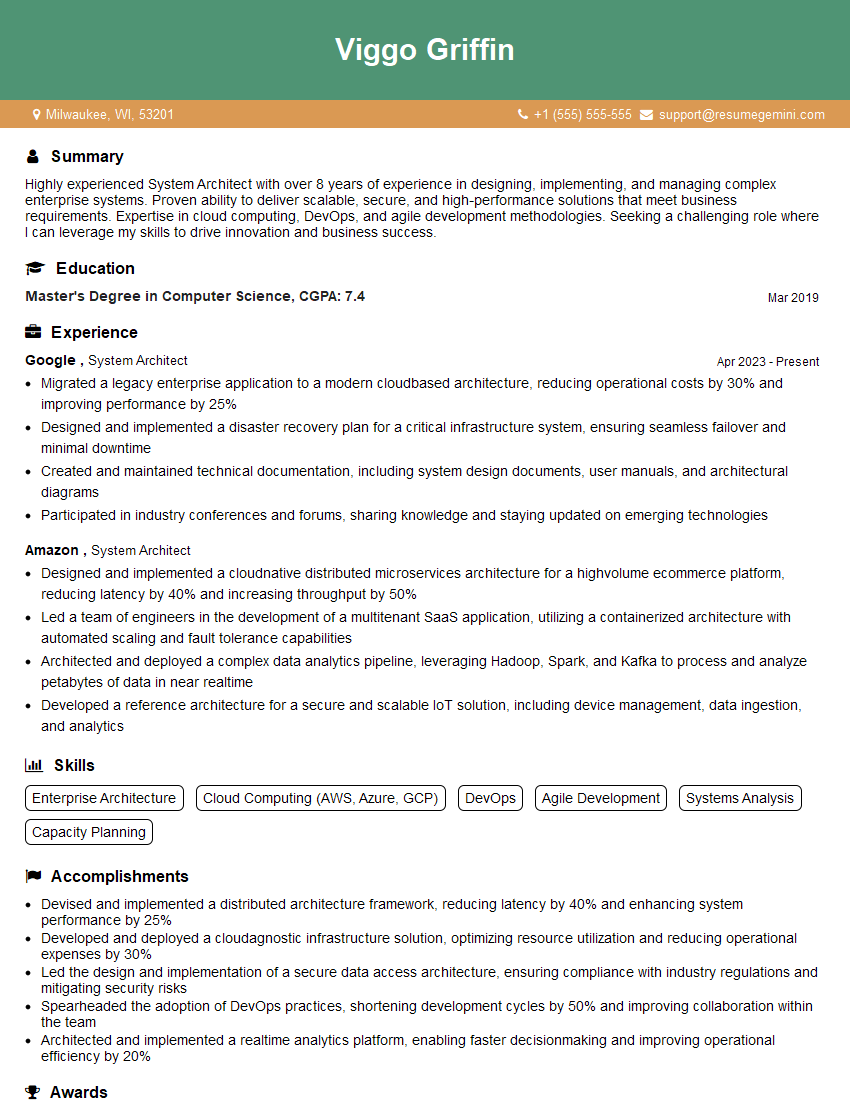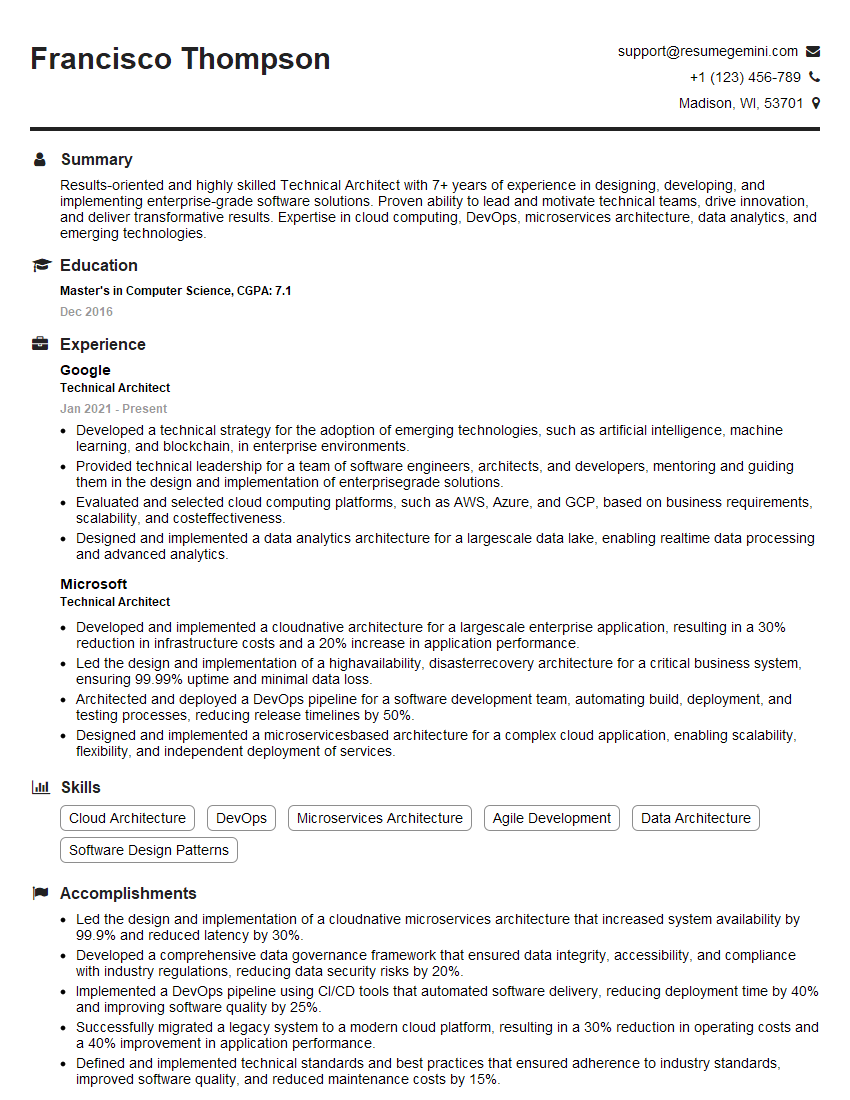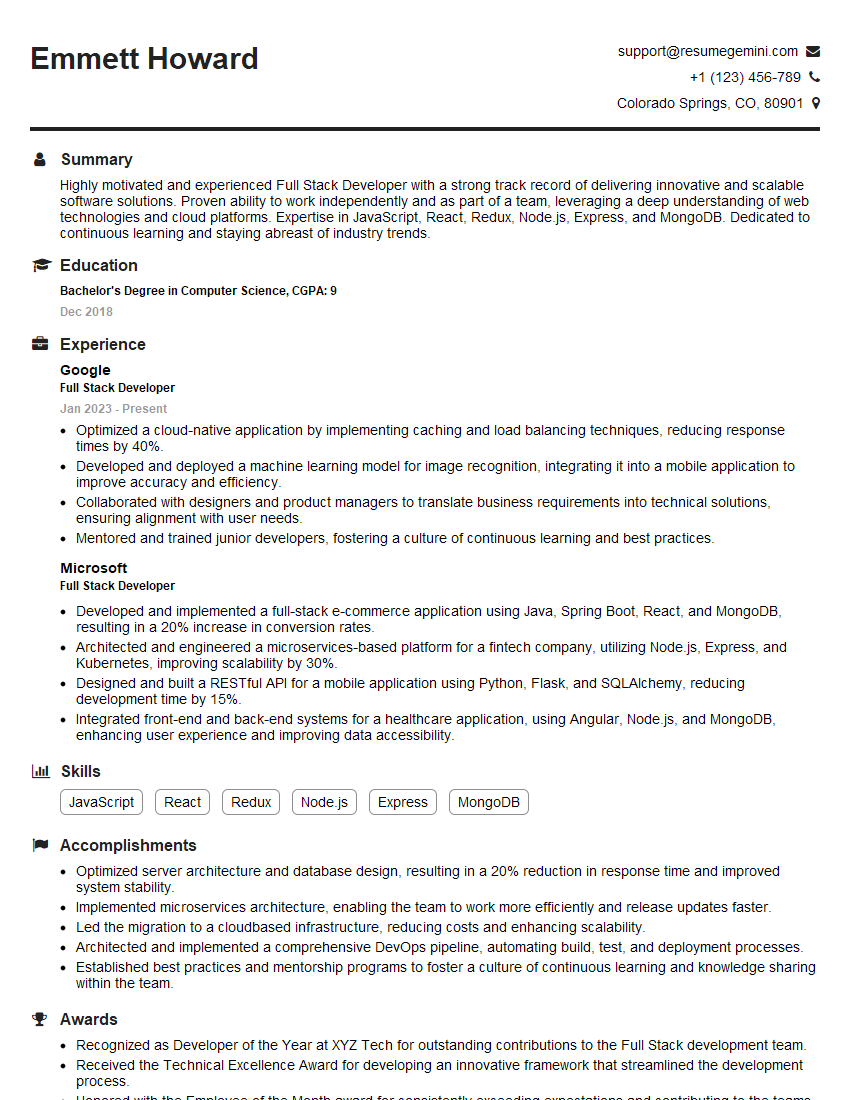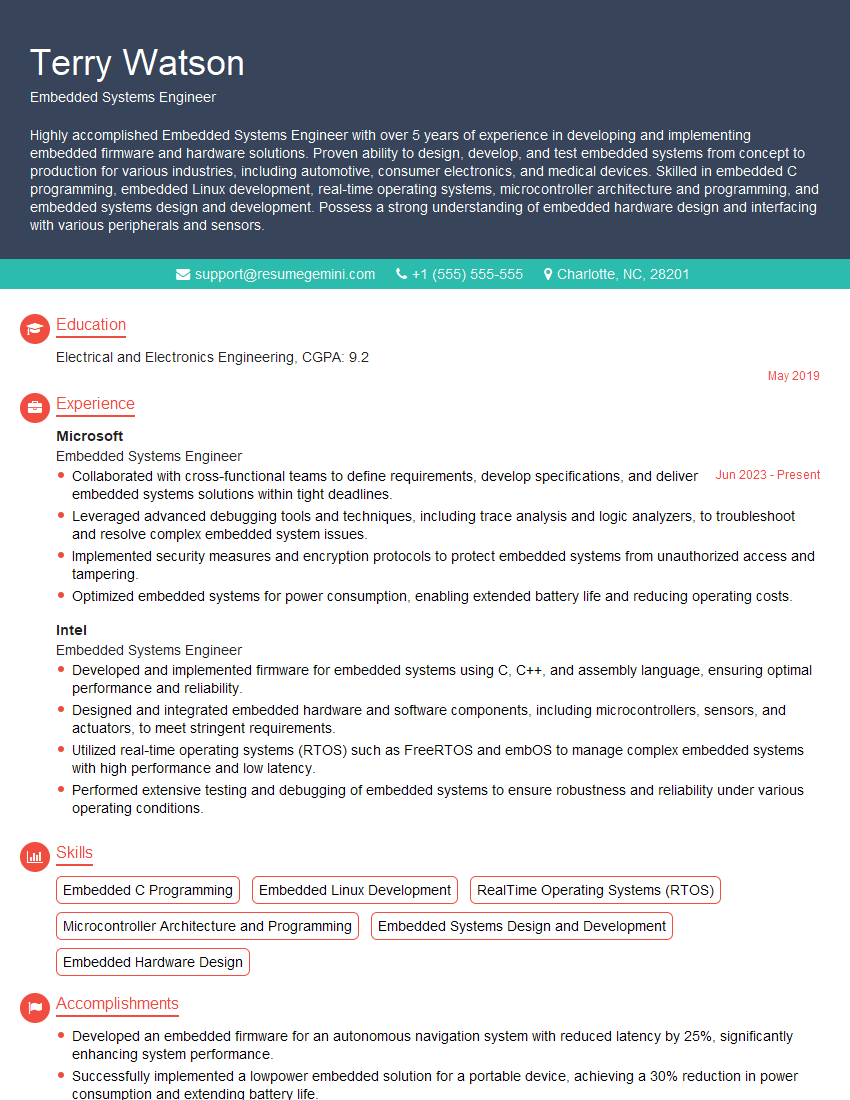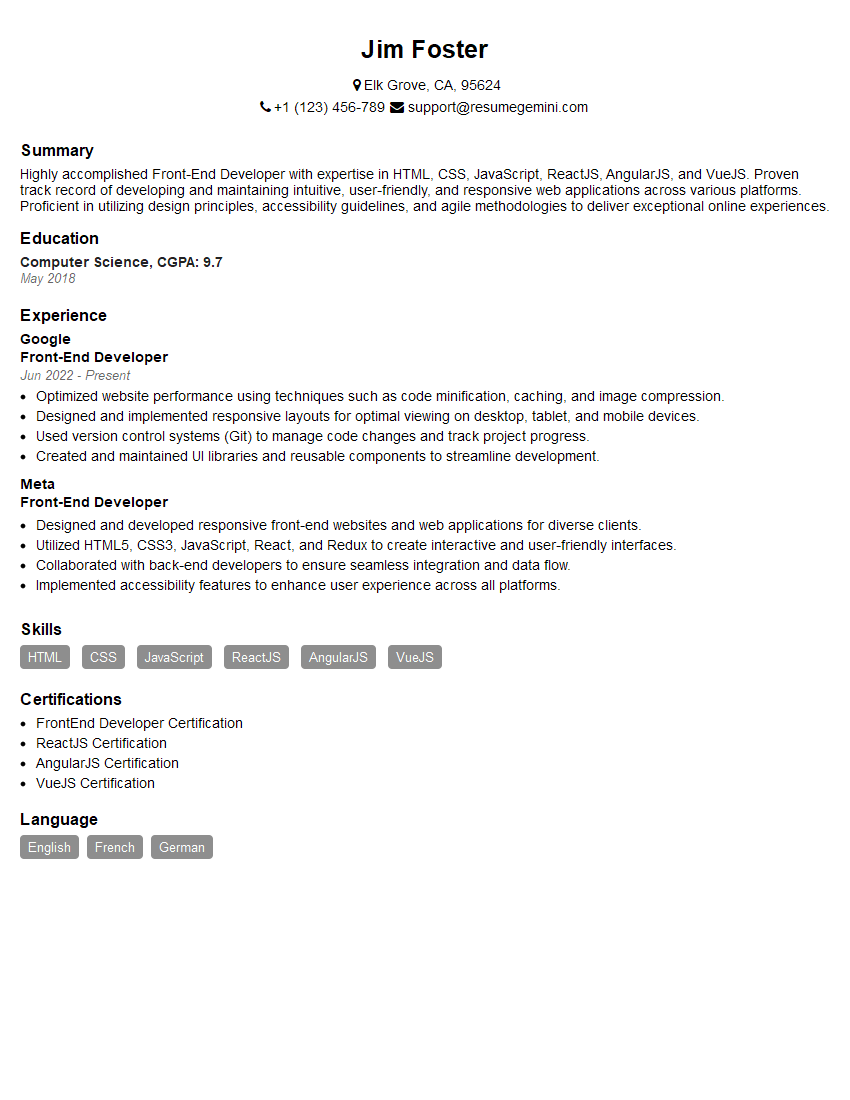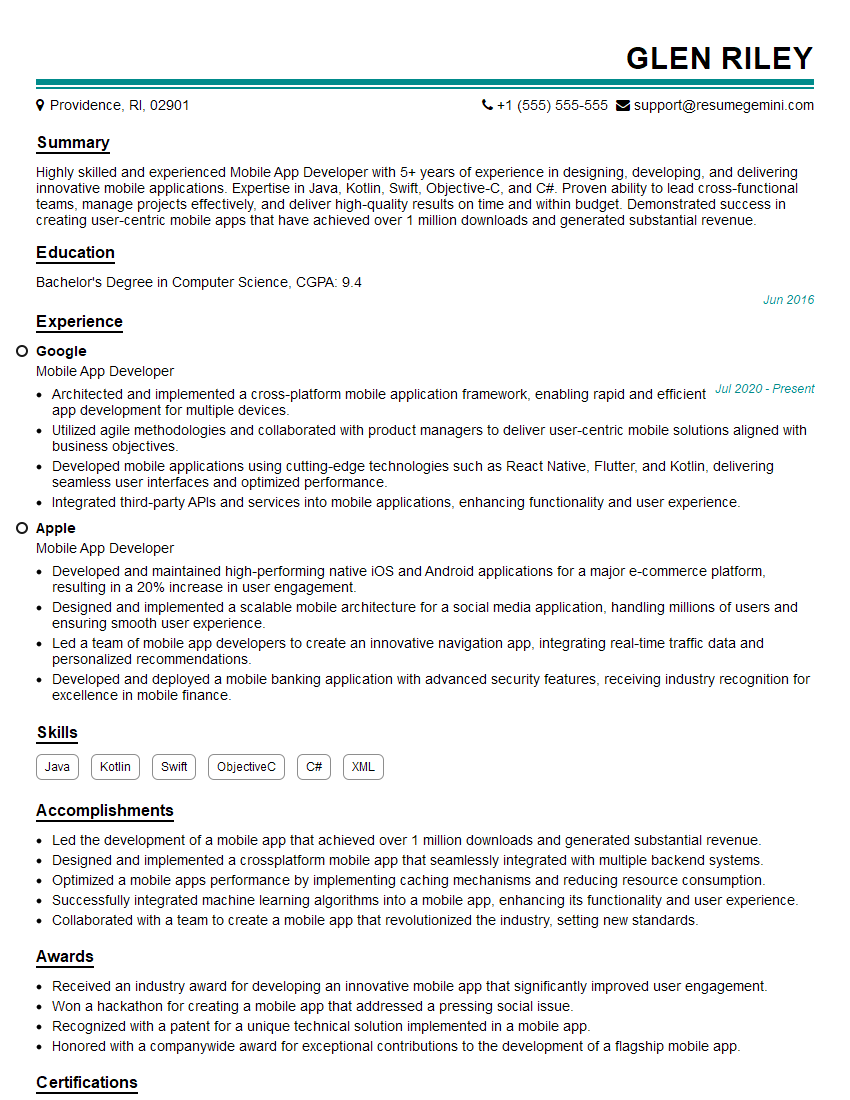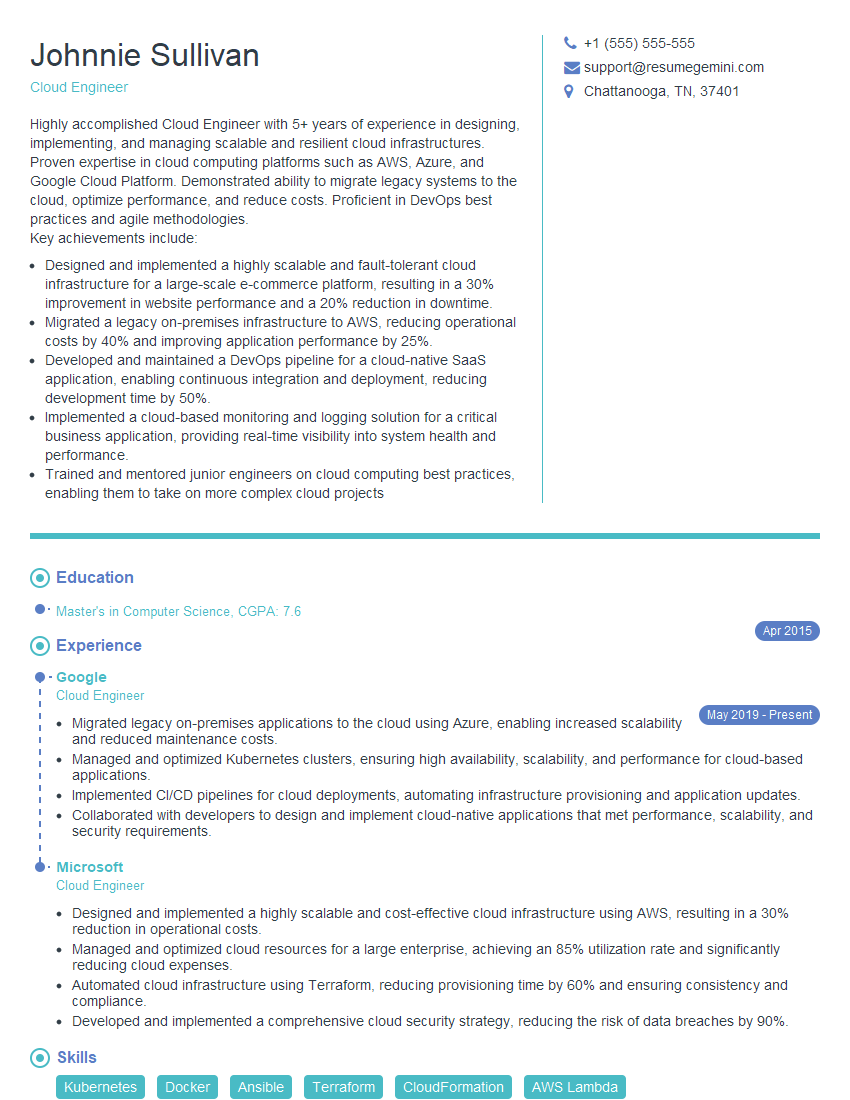Every successful interview starts with knowing what to expect. In this blog, we’ll take you through the top Software Development and Programming interview questions, breaking them down with expert tips to help you deliver impactful answers. Step into your next interview fully prepared and ready to succeed.
Questions Asked in Software Development and Programming Interview
Q 1. Explain the difference between == and === in JavaScript.
In JavaScript, both == and === are used for comparison, but they differ significantly in how they perform the comparison. == is the loose equality operator, while === is the strict equality operator.
The loose equality operator (==) performs type coercion before comparison. This means it attempts to convert the operands to the same type before checking for equality. For example, 1 == '1' evaluates to true because the string ‘1’ is coerced to the number 1 before the comparison.
The strict equality operator (===), on the other hand, does not perform type coercion. It checks for both value and type equality. Therefore, 1 === '1' evaluates to false because, although the values are the same, their types are different (number and string).
Example:
let x = 10;
let y = '10';
console.log(x == y); // true (loose equality)
console.log(x === y); // false (strict equality)In most cases, it’s best practice to use the strict equality operator (===) to avoid unexpected results due to type coercion. This improves code readability and helps prevent subtle bugs.
Q 2. What is the difference between a stack and a queue?
Stacks and queues are both fundamental data structures used to store and manage collections of items, but they differ significantly in how elements are added and removed.
- Stack: A stack follows the Last-In, First-Out (LIFO) principle. Think of a stack of plates – you can only add a new plate to the top, and you can only remove the plate from the top. The last item added is the first item removed. Common stack operations include
push(add an element to the top) andpop(remove the element from the top). - Queue: A queue follows the First-In, First-Out (FIFO) principle. Imagine a queue of people waiting in line – the first person in line is the first person served. The first item added is the first item removed. Common queue operations include
enqueue(add an element to the rear) anddequeue(remove the element from the front).
Example (Conceptual):
Imagine managing function calls in a program. The call stack uses a LIFO structure to keep track of function calls. When a function calls another, the new function is ‘pushed’ onto the stack. When the inner function completes, it’s ‘popped’ off, and execution resumes in the calling function. This ensures proper order of execution and prevents issues like stack overflow (too many nested calls).
Q 3. Describe the SOLID principles of object-oriented programming.
The SOLID principles are five design principles intended to make software designs more understandable, flexible, and maintainable. They are crucial for creating robust and scalable object-oriented applications.
- S – Single Responsibility Principle: A class should have only one reason to change. Each class should have one specific responsibility, making it easier to understand, test, and maintain.
- O – Open/Closed Principle: Software entities (classes, modules, functions, etc.) should be open for extension, but closed for modification. New functionality should be added without altering existing code.
- L – Liskov Substitution Principle: Subtypes should be substitutable for their base types without altering the correctness of the program. Derived classes should behave in a way that’s consistent with their base classes.
- I – Interface Segregation Principle: Clients should not be forced to depend upon interfaces they don’t use. Large interfaces should be broken down into smaller, more specific interfaces.
- D – Dependency Inversion Principle: High-level modules should not depend on low-level modules. Both should depend on abstractions. Abstractions should not depend upon details. Details should depend upon abstractions. This promotes loose coupling and makes code more flexible.
Example: Imagine building an e-commerce system. Following the Single Responsibility Principle, you might have separate classes for handling user accounts, product catalogs, order processing, and payments. Each class focuses on a single task, making the system easier to maintain and scale.
Q 4. What are the different types of database relationships?
Database relationships define how different tables in a database are connected and related to each other. The most common types are:
- One-to-One: One record in a table is related to only one record in another table. Example: A person might have only one passport.
- One-to-Many: One record in a table is related to multiple records in another table. Example: One customer can have many orders.
- Many-to-One: Multiple records in a table are related to one record in another table. This is the inverse of a One-to-Many relationship. Example: Many orders belong to one customer.
- Many-to-Many: Multiple records in one table are related to multiple records in another table. Example: Many students can enroll in many courses. This usually requires a junction table (also known as an associative entity).
These relationships are implemented using foreign keys, which are columns in one table that reference the primary key of another table.
Q 5. Explain the concept of normalization in databases.
Database normalization is a process of organizing data to reduce redundancy and improve data integrity. It involves dividing larger tables into smaller tables and defining relationships between them. This leads to a more efficient and reliable database.
The goal is to minimize data redundancy (having the same data repeated in multiple places) and improve data integrity (ensuring data accuracy and consistency). Redundancy leads to wasted space and potential inconsistencies if data is updated in one place but not others.
Normalization is typically achieved through a series of normal forms, with each form addressing a specific type of redundancy. The most common normal forms are First Normal Form (1NF), Second Normal Form (2NF), and Third Normal Form (3NF). Higher normal forms exist, but they are often less critical in practice.
Example: Imagine a table with customer information, including customer ID, name, address, and order details. This is highly redundant because each customer may have multiple orders. Normalization would separate this into two tables: one for customer information and one for orders, linked by customer ID. This eliminates redundancy and makes updates much easier.
Q 6. What is RESTful API and how does it work?
A RESTful API (Representational State Transfer Application Programming Interface) is a way of designing web services that uses HTTP methods (like GET, POST, PUT, DELETE) to interact with resources. These resources are typically identified by URIs (Uniform Resource Identifiers).
How it works:
- Resources: Data is represented as resources (e.g., users, products, orders). Each resource has a unique URI.
- HTTP Methods: Different HTTP methods are used to perform specific actions on resources: GET (retrieve), POST (create), PUT (update), DELETE (delete).
- Statelessness: Each request from the client to the server is independent of other requests. The server doesn’t store any information about the client’s previous requests.
- Cacheability: Responses can be cached to improve performance.
- Client-Server Architecture: The client and server are separated, improving scalability and flexibility.
- Uniform Interface: A consistent set of conventions is used for interacting with resources.
Example: A RESTful API might have a URI like /users/123 to represent a specific user. A GET request to this URI would retrieve information about user 123. A DELETE request would delete the user.
Q 7. Describe your experience with version control systems (e.g., Git).
I have extensive experience using Git, the most popular distributed version control system. I’ve used Git throughout my career for managing codebases of various sizes and complexities, from small personal projects to large-scale enterprise applications. My proficiency encompasses all core Git functionalities, including:
- Branching and Merging: I regularly utilize branching strategies (like Gitflow) for parallel development and feature isolation. I’m comfortable with merging branches, resolving merge conflicts, and rebasing when appropriate.
- Committing and Pushing: I write clear and concise commit messages that accurately reflect the changes made. I regularly push my code to remote repositories (GitHub, GitLab, Bitbucket).
- Pull Requests/Merge Requests: I’m adept at creating pull/merge requests for code reviews, ensuring code quality and collaboration.
- Remote Collaboration: I work effectively with teams using Git, resolving merge conflicts, and coordinating changes.
- Forking and Cloning: I use forking to create personal copies of repositories and cloning to create local copies for development.
- Version Control Best Practices: I adhere to best practices for version control, including regular commits, meaningful commit messages, and proper branching strategies.
In a recent project, we used Git’s branching capabilities to develop multiple features concurrently, ultimately leading to a faster and more efficient development cycle. My expertise in Git has been instrumental in managing large codebases, collaborating effectively with teams, and ensuring the integrity of our code throughout the development process.
Q 8. Explain the difference between synchronous and asynchronous programming.
Synchronous and asynchronous programming describe how your code handles tasks. Imagine you’re at a restaurant. Synchronous programming is like ordering food and waiting at your table until it arrives – your program stops and waits for the task to finish before moving on. Asynchronous programming is like ordering food and doing something else (e.g., chatting with your friends) while you wait. Your program continues executing other tasks, and gets notified when the food (task) is ready.
In synchronous programming, operations are executed sequentially; one after another. If one operation is slow, the entire program waits. Think of fetching data from a database: a synchronous call blocks execution until the data is returned.
In asynchronous programming, operations overlap. The program doesn’t wait for an operation to complete before starting another. This is ideal for I/O-bound operations (like network requests) that can take a significant time. Callbacks, promises, and async/await are common mechanisms for implementing asynchronous behavior. For example, fetching data asynchronously allows your program to remain responsive while waiting for the network.
// Synchronous example (pseudo-code):
function fetchDataSync() {
const data = fetchFromDatabase(); // Blocks until data is fetched
processData(data);
}
// Asynchronous example (pseudo-code):
function fetchDataAsync() {
fetchFromDatabase().then(data => processData(data)); // Continues execution while fetching data
}
Q 9. What is the purpose of a design pattern?
Design patterns are reusable solutions to commonly occurring problems in software design. They provide a blueprint or template for solving a specific design problem, allowing developers to avoid reinventing the wheel. Think of them as proven architectural styles that enhance code readability, maintainability, and reusability.
For example, the Singleton pattern ensures that only one instance of a class is created. The Factory pattern provides an interface for creating objects without specifying their concrete classes. The Observer pattern defines a one-to-many dependency between objects, where one object notifies its dependents of any state changes. Using a design pattern helps you build robust and understandable code by leveraging established best practices.
Choosing the right design pattern depends heavily on the specific context and goals of the project. A poorly chosen pattern can add unnecessary complexity.
Q 10. Explain the concept of polymorphism.
Polymorphism, meaning “many forms,” is a powerful concept where objects of different classes can be treated as objects of a common type. This allows you to write code that can work with objects of various classes without needing to know their specific type at compile time. It’s like having a toolbox where different tools (classes) can all perform a similar function (method), even if they implement that function differently.
Consider a scenario with different shapes (Circle, Square, Triangle). Each shape class might have a method called calculateArea(). Polymorphism allows you to call calculateArea() on any shape object, and the correct implementation (for Circle, Square, or Triangle) will be executed automatically. This is usually achieved through inheritance and interfaces or abstract classes.
//Example (pseudo-code)
class Shape {
calculateArea() { throw new Error('Must be implemented'); }
}
class Circle extends Shape {
calculateArea() { /* Circle-specific calculation */ }
}
class Square extends Shape {
calculateArea() { /* Square-specific calculation */ }
}
const shapes = [new Circle(), new Square()];
for (const shape of shapes) {
console.log(shape.calculateArea()); // Polymorphic call
}
Q 11. What is the difference between an interface and an abstract class?
Both interfaces and abstract classes promote abstraction, but they differ in their implementation. An interface defines a contract – a set of methods that a class *must* implement. It doesn’t provide any implementation details. Think of it as a specification.
An abstract class, on the other hand, can provide both a contract (abstract methods) and partial implementations (concrete methods). It’s a mix of specification and implementation. You cannot instantiate an abstract class directly; you must extend it with a concrete class.
In essence, an interface says *what* a class should do, while an abstract class defines *what* and *how* (partially).
Java uses interfaces extensively, while many other languages like C# or C++ favor abstract classes for this purpose. The choice between an interface and an abstract class often depends on the specific language features and the design needs of the application. If you only need to define a contract without any implementation detail, an interface is generally preferred for its flexibility and better support for multiple inheritance.
Q 12. What are some common software testing methodologies?
Several software testing methodologies exist, each with its strengths and weaknesses. Some common ones include:
- Unit Testing: Testing individual components or units of code in isolation.
- Integration Testing: Testing the interaction between different units or modules.
- System Testing: Testing the entire system as a whole to ensure it meets requirements.
- Acceptance Testing: Verifying that the system meets the needs and expectations of the end-user.
- Regression Testing: Testing to ensure that new code changes haven’t introduced bugs into existing functionality.
- Black Box Testing: Testing the functionality without knowing the internal workings of the system.
- White Box Testing: Testing the system with knowledge of its internal workings.
The choice of testing methodologies depends on factors like project complexity, budget, and timeline. A comprehensive testing strategy typically involves a combination of these approaches.
Q 13. Describe your experience with Agile development methodologies.
I have extensive experience with Agile development methodologies, primarily Scrum and Kanban. In previous projects, we utilized Scrum’s iterative approach, breaking down large tasks into smaller, manageable sprints (typically two weeks). This allowed us to deliver incremental value quickly and adapt to changing requirements. Daily stand-up meetings fostered effective communication and problem-solving.
In other projects, Kanban’s visual workflow proved effective in managing continuous delivery and prioritizing tasks based on urgency. I’ve actively participated in sprint planning, daily scrums, sprint reviews, and retrospectives. My focus has always been on collaborative teamwork, effective communication, and continuous improvement. Agile’s emphasis on flexibility and adaptability has proven invaluable in dynamic project environments.
For instance, in one project, we used Agile to pivot our strategy midway through development based on valuable user feedback gathered during sprint reviews. This prevented us from building a product that didn’t meet market demands.
Q 14. Explain the concept of dependency injection.
Dependency Injection is a design pattern that promotes loose coupling between software components. Instead of a class creating its dependencies directly, these dependencies are provided (injected) from outside. This improves testability, maintainability, and reusability.
Imagine a car engine needing fuel. In a tightly coupled system, the engine would create its own fuel. In a system using dependency injection, the fuel is provided to the engine externally. This means you can easily switch to different types of fuel (dependencies) without modifying the engine’s internal code.
Common approaches for dependency injection include:
- Constructor Injection: Dependencies are passed through the class constructor.
- Setter Injection: Dependencies are injected through setter methods.
- Interface Injection: Dependencies are provided via an interface.
Dependency Injection simplifies testing by allowing you to easily mock or stub dependencies during testing. It also promotes modularity and makes code more reusable because components are independent of their implementation details.
//Example (pseudo-code) - Constructor Injection
class Engine {
constructor(fuel) { this.fuel = fuel; }
start() { /* Uses the provided fuel */ }
}
const engine = new Engine(new GasolineFuel()); // Dependency Injection
Q 15. How do you handle exceptions in your code?
Exception handling is crucial for writing robust and reliable software. It’s the process of anticipating and gracefully managing errors that might occur during program execution. Instead of letting the program crash, we use exception handling mechanisms to catch these errors, log them appropriately, and potentially recover or take corrective action.
In most languages, this involves try-catch blocks. The code that might throw an exception is placed within a try block. If an exception occurs, the program jumps to the corresponding catch block, which specifies how to handle that particular type of exception.
try { // Code that might throw an exception, e.g., file I/O, network operations int result = 10 / 0; // This will throw an ArithmeticException } catch (ArithmeticException e) { System.err.println("Division by zero error: " + e.getMessage()); // Handle the exception, perhaps by providing a default value or logging the error } catch (IOException e) { System.err.println("IO error: " + e.getMessage()); // Handle IO exceptions differently } finally { // Code that always executes, regardless of whether an exception occurred, e.g., closing resources System.out.println("This always executes."); } Effective exception handling goes beyond simply catching errors. It involves designing your code to anticipate potential failure points and providing informative error messages that aid debugging. It’s also important to avoid catching exceptions too broadly (e.g., catching Exception without specifying the type), as this can mask underlying problems.
Career Expert Tips:
- Ace those interviews! Prepare effectively by reviewing the Top 50 Most Common Interview Questions on ResumeGemini.
- Navigate your job search with confidence! Explore a wide range of Career Tips on ResumeGemini. Learn about common challenges and recommendations to overcome them.
- Craft the perfect resume! Master the Art of Resume Writing with ResumeGemini’s guide. Showcase your unique qualifications and achievements effectively.
- Don’t miss out on holiday savings! Build your dream resume with ResumeGemini’s ATS optimized templates.
Q 16. What are some common design patterns you have used?
Design patterns are reusable solutions to common software design problems. They provide a blueprint for structuring code, promoting maintainability, and improving collaboration. I’ve extensively used several patterns, including:
- Model-View-Controller (MVC): This separates concerns into three interconnected parts: the model (data), the view (presentation), and the controller (logic). I’ve used MVC in numerous web applications to manage user input, update data, and render the interface. This separation makes the code more organized and easier to modify.
- Singleton: This pattern ensures that a class has only one instance and provides a global point of access to it. It’s useful for managing resources like database connections or logging services, where having multiple instances would be inefficient or problematic.
- Factory: This pattern provides an interface for creating objects without specifying the exact class of object that will be created. This allows for greater flexibility and extensibility. For example, a factory could create different database connections based on configuration settings.
- Observer: This pattern defines a one-to-many dependency between objects. When one object changes state, all its dependents are notified and updated automatically. This is useful in scenarios like real-time data updates or event handling.
The choice of design pattern depends heavily on the specific problem being solved. Understanding the trade-offs of each pattern is critical for making informed decisions.
Q 17. Explain the concept of Big O notation.
Big O notation describes the upper bound of the time or space complexity of an algorithm as the input size grows. It’s a way to classify algorithms based on their efficiency. It doesn’t measure the exact runtime, but rather how the runtime scales with increasing input.
For example, O(n) represents linear time complexity – the runtime grows linearly with the input size (n). O(1) represents constant time complexity – the runtime remains constant regardless of input size. O(n^2) represents quadratic time complexity – the runtime grows proportionally to the square of the input size.
Consider searching for an element in an array. A linear search (checking each element one by one) has O(n) complexity. However, a binary search (only applicable on sorted arrays) has O(log n) complexity, which is significantly faster for large datasets.
Understanding Big O notation is essential for choosing efficient algorithms and optimizing performance, particularly when dealing with large amounts of data. It allows developers to compare the scalability of different approaches before implementing them.
Q 18. How do you optimize database queries for performance?
Optimizing database queries is critical for building high-performing applications. Slow queries can significantly impact user experience and overall system responsiveness. Here are key strategies:
- Indexing: Create indexes on frequently queried columns. Indexes are like a table of contents for your data, allowing the database to quickly locate relevant rows without scanning the entire table.
- Query Optimization Techniques: Use
EXPLAIN(or equivalent) to analyze query execution plans and identify bottlenecks. Avoid usingSELECT *; select only the necessary columns. Use appropriate join types (e.g.,INNER JOIN,LEFT JOIN) based on the desired results. OptimizeWHEREclauses by using appropriate operators and avoiding unnecessary calculations. - Database Design: Normalize your database schema to reduce data redundancy and improve data integrity. Properly designing your tables and relationships can dramatically improve query performance.
- Caching: Cache frequently accessed data in memory to reduce database load. Techniques like query caching or using a dedicated caching layer (e.g., Redis, Memcached) can significantly improve performance.
- Connection Pooling: Use connection pooling to reuse database connections, reducing the overhead of establishing new connections for each request.
- Database Tuning: Configure database settings (e.g., buffer pool size, memory allocation) based on your workload and hardware resources. This often requires working closely with database administrators.
Remember that profiling and benchmarking are essential for identifying performance bottlenecks and measuring the effectiveness of optimization efforts. Tools like database profilers and performance monitoring systems can provide valuable insights.
Q 19. What are some common security vulnerabilities in web applications?
Web applications face a wide range of security vulnerabilities. Some of the most common include:
- SQL Injection: Malicious code inserted into database queries to manipulate or steal data. Proper input validation and parameterized queries are essential preventative measures.
- Cross-Site Scripting (XSS): Injecting malicious scripts into web pages viewed by other users. Sanitizing user input and using output encoding are crucial defenses.
- Cross-Site Request Forgery (CSRF): Tricking users into performing unwanted actions on a website they’re already authenticated to. Using CSRF tokens helps mitigate this vulnerability.
- Session Hijacking: Stealing a user’s session ID to impersonate them. Secure session management, HTTPS, and regular password changes help protect against this.
- Insecure Direct Object References (IDOR): Directly accessing objects (e.g., files, records) without proper authorization checks. Implementing robust access control mechanisms is critical.
- Authentication and Authorization Flaws: Weak or improperly implemented authentication systems can allow unauthorized access. Using strong passwords, multi-factor authentication, and appropriate authorization controls is essential.
Following secure coding practices, using a secure framework, and regularly conducting security audits are essential for minimizing the risks of these vulnerabilities.
Q 20. Explain how you would approach debugging a complex software problem.
Debugging complex software problems requires a systematic and methodical approach. My strategy typically involves:
- Reproduce the Issue: First, I need to reliably reproduce the bug. This often involves gathering detailed information from error logs, user reports, or by creating a test case that consistently triggers the problem.
- Isolate the Problem: Once I can reproduce the bug, I try to isolate the specific code section causing it. This might involve using logging statements, breakpoints (in a debugger), or strategically removing parts of the code to pinpoint the source.
- Analyze the Code: I carefully examine the code surrounding the error, looking for logic errors, incorrect data handling, or unexpected interactions between different parts of the system.
- Use Debugging Tools: Debuggers are invaluable for stepping through code line by line, inspecting variables, and understanding the program’s execution flow. Profilers can help identify performance bottlenecks if the issue is related to speed.
- Test and Verify: Once I’ve implemented a fix, I thoroughly test it to ensure the problem is resolved and that no new issues have been introduced. Automated tests are particularly helpful for this step.
- Root Cause Analysis: For recurring or complex bugs, a deeper investigation might be necessary to identify the root cause, preventing similar problems in the future.
Effective debugging requires patience, attention to detail, and a good understanding of the system’s architecture and codebase. Often, collaboration with other team members can provide valuable insights and accelerate the debugging process.
Q 21. What is your preferred programming language and why?
My preferred programming language is Python. While I’m proficient in several languages (including Java, JavaScript, and C++), I find Python particularly well-suited for many tasks due to its readability, versatility, and extensive ecosystem of libraries.
Its clear syntax makes code easier to write, read, and maintain, reducing development time and improving collaboration. The vast array of libraries available (for data science, machine learning, web development, etc.) allows for rapid prototyping and efficient development in various domains. The large and active community provides ample support and readily available resources.
Of course, the ideal language depends on the specific project. For performance-critical applications, I might choose C++ or Java. For front-end web development, JavaScript is essential. But for many general-purpose tasks, Python’s balance of readability, power, and extensive libraries makes it my go-to language.
Q 22. Describe your experience with cloud platforms (e.g., AWS, Azure, GCP).
I have extensive experience working with major cloud platforms, primarily AWS and Azure. My experience spans various services, including compute (EC2, Azure VMs), storage (S3, Azure Blob Storage), databases (RDS, Azure SQL Database), and serverless computing (Lambda, Azure Functions). I’ve used these platforms to deploy and manage applications of varying scales, from small prototypes to large-scale production systems. For example, in a previous role, I was instrumental in migrating a monolithic application to AWS, utilizing EC2 instances for compute, S3 for static asset storage, and RDS for the database. This involved designing a robust deployment pipeline using tools like Terraform for infrastructure as code and Jenkins for continuous integration and continuous deployment (CI/CD). Another project involved building a highly scalable microservices architecture on Azure, leveraging Azure Kubernetes Service (AKS) for orchestration and Azure Container Registry (ACR) for storing container images. My proficiency extends to managing security aspects within these environments, implementing measures like IAM roles and security groups to control access and mitigate risks.
Q 23. What is your experience with containerization technologies (e.g., Docker, Kubernetes)?
My experience with containerization technologies is extensive, focusing primarily on Docker and Kubernetes. I’m comfortable building Docker images, defining Dockerfiles to ensure reproducible builds, and managing containers within various environments. I understand the importance of creating lean and efficient images to minimize attack surface and improve deployment speed. For example, I’ve used multi-stage builds in Docker to reduce the final image size by significantly reducing unnecessary layers. Furthermore, I’ve worked extensively with Kubernetes, managing clusters, deploying applications using YAML manifests, and configuring various Kubernetes features such as deployments, services, and ingress controllers. I have experience with managing Kubernetes resources using tools like kubectl and Helm. A recent project involved deploying a complex microservices application to a Kubernetes cluster in Azure, optimizing resource allocation using horizontal pod autoscaling (HPA) and ensuring high availability through robust deployment strategies. I’m also familiar with container registries like Docker Hub and private registries to securely store and manage container images.
Q 24. Explain your understanding of microservices architecture.
Microservices architecture is a design approach where a large application is structured as a collection of small, autonomous services, each responsible for a specific business function. These services communicate with each other over a network, often using lightweight protocols like REST or gRPC. This approach contrasts with monolithic architectures where all components are tightly coupled. Key benefits of microservices include increased agility (independent deployments), improved scalability (scale individual services as needed), better fault isolation (failure of one service doesn’t bring down the whole application), and technology diversity (different services can use different technologies). However, complexities include increased operational overhead, managing inter-service communication, and data consistency across services. For instance, in a e-commerce application, you might have separate microservices for user accounts, product catalog, shopping cart, order processing, and payment gateway. Each service can be developed, deployed, and scaled independently, improving flexibility and reducing the risk of widespread outages. Managing the complexity often involves using tools like service meshes (Istio, Linkerd) for traffic management and observability.
Q 25. How do you ensure code quality and maintainability?
Ensuring code quality and maintainability is paramount. My approach involves a multi-faceted strategy: First, I prioritize writing clean, well-documented code that adheres to coding standards and best practices. I use linters and static analysis tools (like ESLint for JavaScript, Pylint for Python) to automatically detect potential issues early in the development cycle. Second, I embrace test-driven development (TDD), writing unit, integration, and end-to-end tests to ensure the code functions as expected and to provide regression protection. I utilize testing frameworks like Jest, pytest, or JUnit depending on the project’s technology stack. Third, I believe in the power of code reviews, both giving and receiving feedback to identify potential flaws and improve code quality collaboratively. Finally, I actively monitor application performance using monitoring and logging tools and incorporate metrics and alerting to proactively identify and address issues. This holistic approach enhances code quality, reducing bugs and making the code easier to understand, maintain, and evolve over time.
Q 26. Describe a challenging technical problem you faced and how you solved it.
In a previous project, we encountered a significant performance bottleneck in our database during peak hours. The application, a high-traffic social media platform, experienced slow response times and frequent timeouts. To troubleshoot, we initially profiled the database queries using tools like pgAdmin (PostgreSQL) to identify the slowest queries. We found that a specific query responsible for fetching user timelines was incredibly inefficient. We optimized the query using indexes and refactored the underlying data model to improve data retrieval efficiency. Additionally, we implemented caching mechanisms using Redis to store frequently accessed user timeline data, drastically reducing database load. We also monitored the CPU and memory usage of the database server to ensure it was adequately provisioned. This multi-pronged approach significantly improved database performance, resolving the slow response times and timeouts and preventing future scalability issues. The improvements resulted in a noticeable decrease in latency and a substantial increase in the application’s overall throughput.
Q 27. What are your strengths and weaknesses as a software developer?
My strengths lie in my problem-solving abilities, my proactive approach to learning new technologies, and my collaborative nature. I enjoy tackling challenging problems and finding innovative solutions. I’m a quick learner and consistently seek opportunities to expand my skillset, keeping myself updated with the latest advancements in software development. I excel in team environments, valuing effective communication and collaboration. My weakness, if I had to identify one, would be a tendency to be perfectionistic, sometimes leading to spending excessive time on minor details. However, I’m actively working on improving time management and prioritization techniques to mitigate this. I recognize the importance of delivering high-quality work within reasonable deadlines and am constantly striving for balance between thoroughness and efficiency.
Q 28. Where do you see yourself in five years?
In five years, I see myself as a senior software engineer or technical lead, playing a significant role in architecting and developing complex, scalable systems. I aim to continue deepening my expertise in cloud computing, microservices architecture, and DevOps practices. I envision myself mentoring junior engineers and contributing to a team’s technical growth. My goal is to leverage my experience and skills to solve challenging problems and contribute meaningfully to the success of a technologically driven organization, potentially leading initiatives that drive innovation and improvement.
Key Topics to Learn for Software Development and Programming Interviews
- Data Structures and Algorithms: Understanding fundamental data structures like arrays, linked lists, trees, graphs, and hash tables, and their associated algorithms is crucial. Practical application includes optimizing code for efficiency and solving complex problems.
- Object-Oriented Programming (OOP): Mastering concepts like encapsulation, inheritance, polymorphism, and abstraction is essential for building robust and maintainable software. Practical application includes designing well-structured and scalable applications.
- Databases: Familiarity with relational (SQL) and NoSQL databases is vital. Practical application involves designing database schemas, writing efficient queries, and understanding database normalization.
- Software Design Principles: Understanding SOLID principles and design patterns helps in creating clean, modular, and easily maintainable code. Practical application includes building complex systems that are easily adaptable to changing requirements.
- Version Control (Git): Proficiency in Git is a must-have skill for collaboration and managing code effectively. Practical application includes branching, merging, resolving conflicts, and understanding Git workflows.
- System Design: For senior roles, understanding system design principles, including scalability, availability, and consistency, is critical. Practical application includes designing high-performance and fault-tolerant systems.
- Testing and Debugging: Understanding different testing methodologies (unit, integration, system) and debugging techniques is important for producing high-quality software. Practical application involves writing unit tests and effectively identifying and resolving bugs.
- Specific Programming Languages: Deep understanding of at least one or two programming languages relevant to your target roles (e.g., Java, Python, C++, JavaScript) is crucial. Practical application includes writing efficient and clean code in your chosen language.
Next Steps
Mastering Software Development and Programming opens doors to exciting and rewarding career opportunities with significant growth potential. To maximize your job prospects, creating a strong, ATS-friendly resume is essential. ResumeGemini is a trusted resource to help you build a professional resume that highlights your skills and experience effectively. We provide examples of resumes tailored specifically to Software Development and Programming to guide you in this process.
Explore more articles
Users Rating of Our Blogs
Share Your Experience
We value your feedback! Please rate our content and share your thoughts (optional).
What Readers Say About Our Blog
Hi, I represent an SEO company that specialises in getting you AI citations and higher rankings on Google. I’d like to offer you a 100% free SEO audit for your website. Would you be interested?
Dear Sir/Madam,
Do you want to become a vendor/supplier/service provider of Delta Air Lines, Inc.? We are looking for a reliable, innovative and fair partner for 2025/2026 series tender projects, tasks and contracts. Kindly indicate your interest by requesting a pre-qualification questionnaire. With this information, we will analyze whether you meet the minimum requirements to collaborate with us.
Best regards,
Carey Richardson
V.P. – Corporate Audit and Enterprise Risk Management
Delta Air Lines Inc
Group Procurement & Contracts Center
1030 Delta Boulevard,
Atlanta, GA 30354-1989
United States
+1(470) 982-2456


